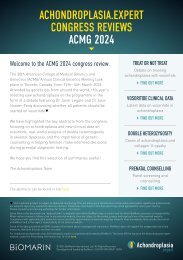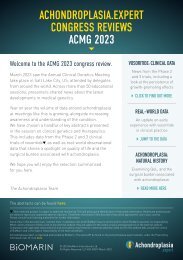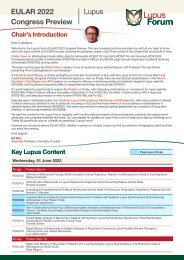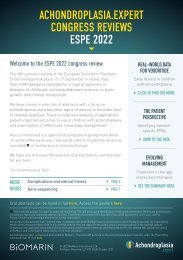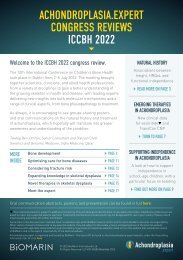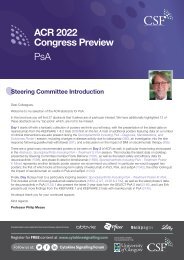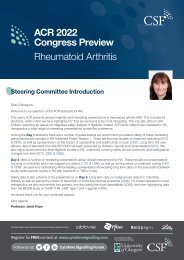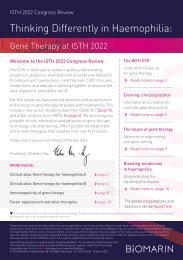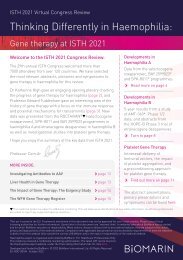ESPE congress review 23
The 61st annual meeting of the European Society for Paediatric Endocrinology (ESPE) took place in The Hague, Netherlands, from 21–23 September 2023. The theme for the meeting was Global Challenges in Paediatric Endocrinology, which included sessions on growth, as well as bone, growth plate, and mineral metabolism.
The 61st annual meeting of the European Society for Paediatric Endocrinology (ESPE) took place in The Hague, Netherlands, from 21–23 September 2023. The theme for the meeting was Global Challenges in Paediatric Endocrinology, which included sessions on growth, as well as bone, growth plate, and mineral metabolism.
Create successful ePaper yourself
Turn your PDF publications into a flip-book with our unique Google optimized e-Paper software.
ACHONDROPLASIA.EXPERT<br />
CONGRESS REVIEWS<br />
<strong>ESPE</strong> 20<strong>23</strong><br />
Welcome to the <strong>ESPE</strong> 20<strong>23</strong> <strong>congress</strong> <strong>review</strong>.<br />
The 61st annual meeting of the European Society for Paediatric<br />
Endocrinology (<strong>ESPE</strong>) took place in The Hague, Netherlands, from<br />
21–<strong>23</strong> September 20<strong>23</strong>. The theme for the meeting was Global<br />
Challenges in Paediatric Endocrinology, which included sessions on<br />
growth, as well as bone, growth plate, and mineral metabolism.<br />
We have picked out abstracts with a focus on children with<br />
achondroplasia. This includes new clinical data, real-world<br />
analyses, and a look at the underlying genetics. Also summarised<br />
is a sponsored symposium, looking at integrating clinical and<br />
real-world evidence to improve strategies.<br />
We hope this selection of summaries is useful to you, and<br />
perhaps shines a light on ways in which we can address global<br />
challenges in our own small corner of endocrinology.<br />
NEW CLINICAL DATA IN<br />
ACHONDROPLASIA<br />
Findings for vosoritide<br />
and infigratinib<br />
CLICK FOR THE SUMMARY<br />
REAL-WORLD<br />
EXPERIENCE WITH<br />
VOSORITIDE<br />
Results from<br />
early-access and<br />
registry populations<br />
EXPLORE THE DATA<br />
The Achondroplasia Team<br />
MORE<br />
INSIDE<br />
Bone and surgery PAGE 9<br />
Genetics PAGE 10<br />
Advancing Care PAGE 12<br />
EXPLORING COMMON<br />
COMPLICATIONS<br />
Insulin resistance<br />
and hearing loss<br />
FIND OUT MORE<br />
Oral abstracts can be found in full here. Access the ePosters here.<br />
This medicinal product is subject to additional monitoring. This will allow quick identification of new safety information. Healthcare professionals<br />
are asked to report any suspected adverse reactions. Treatments mentioned in this document may not be approved for use in your country.<br />
Please consult local licensing authorities for further information.<br />
Some links in this document are “external links” to websites over which BioMarin has no control and for which BioMarin assumes no responsibility.<br />
When visitors choose to follow a link to any external website, they are subject to the cookie, privacy and legal policies of the external website.<br />
Compliance with applicable data protection and accessibility requirements of external websites linked to from this website falls outside the control<br />
of BioMarin and is the explicit responsibility of the external website.<br />
Achondroplasia.expert is organised and funded by BioMarin. The latest API be found on the Achondroplasia.expert website, under the Prescribing<br />
Information tab. Or click here.<br />
© 20<strong>23</strong> BioMarin International Ltd.<br />
All Rights Reserved. EUCAN-VOX-00074 November 20<strong>23</strong><br />
1
Achondroplasia.expert Congress Reviews: <strong>ESPE</strong> 20<strong>23</strong><br />
NEW CLINICAL DATA IN ACHONDROPLASIA<br />
Achondroplasia is the most common skeletal dysplasia. Traditionally, there<br />
have been no disease-modifying treatments for this condition, but increasing<br />
understanding of the role of pathogenic variants in the FGFR3 gene has resulted<br />
in novel targeted therapies.<br />
Clinical trial results for vosoritide have<br />
previously been published for children<br />
aged 5–18 years, 1 and further data shared<br />
for younger children aged 3 months to<br />
5 years. In their latest abstract, Savarirayan<br />
et al. present results from an open-label<br />
Forest plot of differences in mean change from baseline in height; children ≥2 years<br />
Timepoint Studies Comparator Number of subjects Treatment<br />
Vosoritide Comparator difference<br />
1 year<br />
Study 111-206 (FAS randomized)<br />
Study 111-206 (FAS)<br />
Study 111-206 (FAS randomized)<br />
Study 111-206/111-208<br />
Study 111-206/111-208<br />
Study 111-206/111-208<br />
Study 111-206/111-208<br />
2 year<br />
Study 111-206/111-208<br />
Study 111-206/111-208<br />
Study 111-206/111-208<br />
Study 111-206/111-208<br />
3 year<br />
Study 111-206/111-208<br />
Study 111-206/111-208<br />
Study 111-206/111-208<br />
Study 111-206/111-208<br />
4 year<br />
Study 111-206/111-208<br />
Study 111-206/111-208<br />
Study 111-206/111-208<br />
AchNH reference derived from CLARITY. 4<br />
111-206 placebo<br />
111-206 placebo<br />
AchNH longitudinal<br />
AchNH longitudinal<br />
AchNH cross-sectional<br />
Obs/Pbo longitudinal<br />
Obs/Pbo cross-sectional<br />
AchNH longitudinal<br />
AchNH cross-sectional<br />
Obs/Pbo longitudinal<br />
Obs/Pbo cross-sectional<br />
AchNH longitudinal<br />
AchNH cross-sectional<br />
Obs/Pbo longitudinal<br />
Obs/Pbo cross-sectional<br />
AchNH longitudinal<br />
AchNH cross-sectional<br />
Obs/Pbo cross-sectional<br />
15<br />
19<br />
15<br />
34<br />
34<br />
34<br />
34<br />
30<br />
30<br />
30<br />
30<br />
22<br />
22<br />
22<br />
22<br />
8<br />
9<br />
9<br />
extension study spanning up to 4 years’<br />
treatment in 34 children aged 2–5 years at<br />
study start, looking at the persistence of<br />
growth-promoting effects in these infants<br />
and toddlers. Comparative cross-sectional<br />
analyses were performed for each year of<br />
16<br />
16<br />
124<br />
198<br />
761/701<br />
72<br />
77/134<br />
146<br />
725/614<br />
55<br />
80/163<br />
107<br />
672/484<br />
21<br />
80/167<br />
30<br />
444/254<br />
79/109<br />
0.96<br />
0.87<br />
1.85<br />
1.76<br />
1.66<br />
1.37<br />
0.92<br />
2.79<br />
2.89<br />
2.21<br />
1.86<br />
4.10<br />
4.12<br />
3.26<br />
3.06<br />
6.41<br />
7.77<br />
6.27<br />
-1<br />
Comparator<br />
better<br />
Treatment difference (95% Cl)<br />
Vosoritide minus comparator<br />
0 1 2 3 4 5 6 7 8 9<br />
Height (cm)<br />
Vosoritide<br />
better<br />
Savarirayan et al. [FC4.6]<br />
follow-up based on two control groups:<br />
observational/placebo data from the earlier<br />
clinical trials, 2,3 and an external natural<br />
history dataset from CLARITY. 4 The abstract<br />
shared at <strong>ESPE</strong> 20<strong>23</strong> reports that vosoritide<br />
remained well-tolerated – with no change<br />
in the AE profile, and no discontinuations<br />
due to TRAE. After 4 years, treated children<br />
demonstrated greater height gain compared<br />
with both untreated controls and matched<br />
children from CLARITY; LSM change of<br />
6.27 cm and 7.77 cm, respectively. The<br />
change in mean height Z-score at Year 4<br />
was +1.10 for treated versus untreated,<br />
and +1.42 for treated versus CLARITY.<br />
Compared with the observational/placebo<br />
control group, those receiving vosoritide<br />
also showed an improvement in upper-tolower<br />
body segment ratio after 4 years. The<br />
authors conclude that vosoritide was well<br />
tolerated, and maintained positive effects on<br />
linear growth over time. This treatment effect<br />
Mean (SE) change from baseline in AHV at Month 6, in cm/year<br />
4<br />
3.5<br />
3<br />
2.5<br />
2<br />
1.5<br />
1<br />
0.5<br />
0<br />
+0.22<br />
Cohorts 1–3<br />
0.016–0.064<br />
mg/kg/day<br />
+1.52<br />
P=0.02<br />
Cohort 4<br />
0.128<br />
mg/kg/day<br />
+3.38<br />
P=0.001<br />
Cohort 5<br />
0.250<br />
mg/kg/day<br />
N 37<br />
11 12<br />
P-values: 6-month AHV versus baseline AHV. Data shown is restricted to children aged ≥5 years,<br />
except in Cohort 5, which includes one child who turned 5 between screening and dosing.<br />
on growth in young children who started<br />
vosoritide before the age of 5 demonstrates<br />
the benefit of early treatment initiation.<br />
[FC4.6]<br />
Savarirayan et al. also shared results from an<br />
open-label, dose-finding study for infigratinib<br />
– an oral, selective FGFR1-3 tyrosine kinase<br />
inhibitor being investigated for children with<br />
achondroplasia. PROPEL2 included 72 children<br />
aged 3−11 who had already participated<br />
for at least 6 months in PROPEL, a noninterventional<br />
clinical assessment. The doseescalation<br />
phase included five dose cohorts,<br />
ascending from 0.016 to 0.25 mg/kg/day.<br />
Results from over 6 months’ treatment<br />
found that Cohorts 1–3 (n=37) did not have<br />
a significant increase in AHV; these doses<br />
(0.016, 0.032, 0.064 mg/kg/day) were assessed<br />
as non-efficacious. Treatment at the Cohort 4<br />
dose (0.128 mg/kg/day) resulted in an AHV<br />
increase from baseline of 1.52 cm/year in<br />
Cohort 5 n=12<br />
Female:Male ratio 7:5<br />
Mean age (year)<br />
Achondroplasia.expert Congress Reviews: <strong>ESPE</strong> 20<strong>23</strong><br />
11 children aged 5 or older (P=0.02).<br />
However, infigratinib at the Cohort 5 dose<br />
of 0.25 mg/kg/day (n=10) resulted in a<br />
significant mean increase from baseline<br />
of 3.03 cm/year (P=0.0022). Overall, 83% of<br />
children in Cohort 5 responded to infigratinib<br />
with an increase in AHV of at least 25%<br />
compared with baseline. This increase in<br />
growth translates to an increase in Z-score<br />
of +0.29 SDS compared with achondroplasia<br />
growth charts, and +0.25 SDS compared<br />
with average height growth charts. In the<br />
6 children in Cohort 5, collagen X marker –<br />
a biomarker of endochondrial ossification –<br />
also showed a median increase of 28% from<br />
baseline at Month 6. Furthermore, infigratinib<br />
was well tolerated, with no serious AEs<br />
or AEs leading to discontinuation, and<br />
most AEs reported were mild or moderate<br />
in severity. At the Cohort 5 dose, there<br />
were no Grade 3 AEs or TRAEs reported,<br />
no hyperphosphatemia, no ocular AEs,<br />
and no accelerated progression of bone age.<br />
Based on these findings, the 0.25 mg/kg/day<br />
dose will be explored in a Phase 3 study.<br />
The authors note that, if the Phase 2<br />
data are confirmed, infigratinib could<br />
potentially offer children with achondroplasia<br />
the first effective oral therapy to improve<br />
growth, enhance functionality, and<br />
decrease medical complications.<br />
[RFC4.6]<br />
Height Z-scores of patients treated for 12 months referenced to untreated achondroplasia population 4 over time<br />
2.0<br />
1.5<br />
ACH Height Z-score<br />
1.0<br />
0.5<br />
0.0<br />
-0.5<br />
-1.0<br />
Baseline Month 3 Month 6 Month 12<br />
Overall (n=22) Male (n=10) Female (n=12)<br />
REAL-WORLD EXPERIENCE WITH VOSORITIDE<br />
Vosoritide, an analogue of C-type natriuretic peptide, has been developed<br />
for the treatment of short stature in children with achondroplasia, and was<br />
approved by the EMA in August 2021 for children aged 2 and up.<br />
With the introduction of new targeted drugs,<br />
a better knowledge of the natural history<br />
of achondroplasia is essential to plan the<br />
healthcare resources required by individuals<br />
through the lifespan. Kunkel et al. share<br />
insights into the real-world experience with<br />
vosoritide from CrescNet ® , a patient-registry<br />
at the University of Leipzig that has been<br />
used for 20 years to monitor auxological,<br />
laboratory, and treatment data in over<br />
1 million children with various conditions.<br />
To date, 270 children with achondroplasia<br />
have been entered by 15 centres, and 105 of<br />
these have started treatment with vosoritide.<br />
The mean age at vosoritide initiation is<br />
7.1 years, and so far the registry has a<br />
documented treatment duration of 1.<strong>23</strong> years.<br />
Using achondroplasia-specific reference<br />
data, 5 an increase from 0.53 to 1.06 H-SDS<br />
has been confirmed, which is consistent<br />
with data from clinical trials. These findings<br />
suggest that this established registry can be<br />
used to evaluate the long-term outcomes<br />
of rare diseases such as achondroplasia,<br />
and monitor the frequency of multisystemic<br />
complications, including AFMS, and the use<br />
of healthcare resources. [P1-414]<br />
In June 2021, the French health authorities<br />
granted early access to vosoritide for children<br />
aged 5 years or older with open epiphyses.<br />
This programme continued until the agent<br />
was commercially available in December<br />
2022. In a session on growth and syndromes,<br />
Cormier-Daire et al. reported real-world<br />
safety and effectiveness findings from<br />
57 patients in the French early-access cohort,<br />
with mean treatment exposure of 277 days.<br />
The mean age at initiation was 8.6, and<br />
52% of those taking part were male. Among<br />
22 patients (39%) who completed 12 months<br />
of treatment, males (n=10) showed a mean<br />
height increase from baseline of 5.8 cm,<br />
with a Z-score improvement of 1.0; females<br />
(n=12) showed a mean increase of 6.5 cm<br />
and Z-score improvement of 1.2. After 6<br />
months’ treatment (n=37), the mean AGV was<br />
5.8 and 6.3 cm/year in males and females,<br />
respectively. In total, 21 AEs were reported<br />
during the study period; all were mild, and<br />
the majority were injection-site reactions<br />
and vomiting. No serious AEs were reported.<br />
In all, 43 missed doses were reported by<br />
14 patients, but no patients discontinued<br />
vosoritide. The conclusion of the abstract<br />
Cormier-Daire et al. [RFC4.5]<br />
was that vosoritide under real-world<br />
conditions has a safety and effectiveness<br />
profile consistent with that seen in<br />
the clinical trials. In this early access<br />
programme, patients demonstrated good<br />
adherence and remained on treatment.<br />
Long-term data collection for these patients<br />
will continue where possible through the<br />
post-authorisation safety study. [RFC4.5]<br />
ACORN is a multicentre, non-interventional<br />
post-authorisation safety study for vosoritide<br />
that was requested by the EMA as part of<br />
the risk management plan. During <strong>ESPE</strong>,<br />
Pimenta et al. presented the study’s design<br />
and objectives, including its aim to recruit<br />
approximately 330 patients into two cohorts.<br />
The first will be ~300 incident users aged<br />
≥2 to ≤8 years, defined as those who either<br />
recently started, or plan to start treatment<br />
with vosoritide. The second cohort will be<br />
~30 prevalent users aged ≥2 years who<br />
initiated treatment as part of the French<br />
4 5
Achondroplasia.expert Congress Reviews: <strong>ESPE</strong> 20<strong>23</strong><br />
expanded access programme or vosoritide<br />
open-label clinical trial. Patients will<br />
be recruited from around 30 sites in<br />
8–10 countries. The primary objective is to<br />
evaluate the long-term impact of vosoritide<br />
on bone-related safety events, such as<br />
fractures and slipped capital femoral<br />
epiphyses. Secondary objectives include the<br />
long-term impact on safety and diseaserelated<br />
outcomes, including achondroplasiarelated<br />
complications, surgeries, and<br />
changes in height and weight. The study<br />
ACORN study design<br />
Incident users<br />
Prevalent users<br />
Patients not yet treated with commercial vosoritide<br />
Patients having commenced<br />
treatment with vosoritide<br />
Patient enrolled<br />
in clinical trial<br />
EAP<br />
Clinical trial<br />
French EAP<br />
period is 10 years from the first patient<br />
enrolment in April 20<strong>23</strong>. In addition, patients<br />
who complete (reach final adult height) or<br />
discontinue during the study, will be followed<br />
up 2 years later. Almost all vosoritide-treated<br />
patients aged ≥2 to ≤8 years will be eligible<br />
for the study, leading to a more representative<br />
population of achondroplasia patients than<br />
that seen in clinical trials. The authors hope<br />
that the observational data collected in<br />
ACORN will reflect standard clinical practice<br />
and real-life management. [T8]<br />
9 month<br />
maximum*<br />
9 month<br />
maximum<br />
Enrollment<br />
Start of<br />
treatment<br />
Cohort 1<br />
Cohort 2<br />
Study Period<br />
Observational<br />
Period<br />
*Except for patients who commenced treatment with vosoritide after EU MA but before first patient enrolled<br />
End of<br />
treatment<br />
Post-treatment<br />
End of<br />
Study<br />
Pimenta et al. [T8]<br />
EXPLORING COMMON COMPLICATIONS<br />
Achondroplasia is associated with a number of medical complications<br />
throughout the lifespan. Here, we focus on findings from two groups looking<br />
at insulin resistance, and hearing loss in real-world populations.<br />
Acanthosis nigricans is common in<br />
conditions associated with reduced insulin<br />
sensitivity, and has been reported in skeletal<br />
dysplasias due to FGFR3 mutations. Balcı<br />
et al. set out to explore obesity and insulin<br />
resistance in patients with achondroplasia<br />
– specifically those carrying the FGFR3<br />
variant c.1138G>A (p.Gly380Arg). Physical<br />
examination, anthropometric measurements,<br />
and puberty examination were carried out, as<br />
well as measures of fasting plasma glucose,<br />
insulin, HbA1c, and an oral glucose tolerance<br />
test. A total insulin level of 300 U/mL was<br />
accepted as a cutoff for decreased insulin<br />
sensitivity. The study included 28 patients<br />
with a mean age of 13.1 years. All had a<br />
fasting plasma glucose in normal range,<br />
and the oral glucose tolerance was normal<br />
in 75%. Insulin resistance was identified in<br />
6 patients (21.4%), and a further 2 (7.1%) had<br />
impaired glucose tolerance at 120 minutes.<br />
Of note, all patients with insulin resistance<br />
or impaired glucose tolerance were obese<br />
or overweight. HOMA-IR was >2.5 in 80% of<br />
patients with insulin resistance. Additionally,<br />
50% of all patients (n=14) had acanthosis<br />
nigricans. When looking at oral glucose<br />
tolerance in the acanthosis nigricans<br />
subset, 21.4% had insulin resistance and<br />
7.1% had impaired glucose tolerance; the<br />
remainder were normal. Only one patient<br />
with impaired glucose tolerance and<br />
one with insulin resistance did not have<br />
acanthosis nigricans. Although the frequency<br />
of acanthosis nigricans was high in this group<br />
of young people with achondroplasia, it was<br />
not possible to demonstrate a significant<br />
relationship with insulin resistance.<br />
Analyses revealed no significant correlation<br />
between insulin resistance and age, H-SDS,<br />
or HbA1c level; however, a significant<br />
positive correlation was found between<br />
BMI and HOMA-IR (P=0.003). The authors<br />
conclude that the frequency of obesity and<br />
insulin resistance is high in children with<br />
achondroplasia. Monitoring is important,<br />
but HOMA-IR alone is not sufficient. They<br />
recommend an oral glucose tolerance test<br />
as a safe and practical method to check for<br />
glucose metabolism. Furthermore, efforts<br />
to prevent obesity may avert the decrease in<br />
insulin sensitivity. [P1-413]<br />
Hearing loss and ENT problems are<br />
frequent in children with achondroplasia.<br />
Current international consensus guidelines<br />
recommend audiological assessment before<br />
the age of 1 year, and thereafter for children<br />
with speech delay, hearing difficulties, or<br />
features of middle ear effusion. 6 In January<br />
2019, an annual screening programme was<br />
initiated for children with achondroplasia who<br />
attend the Complex Bone Clinic at the Royal<br />
Hospital for Children in Glasgow, Scotland.<br />
At <strong>ESPE</strong>, Watt et al. presented a poster<br />
assessing whether the screening programme<br />
6 7
Achondroplasia.expert Congress Reviews: <strong>ESPE</strong> 20<strong>23</strong><br />
is an effective use of resources, and has<br />
a good detection rate for new ontological<br />
problems. A retrospective analysis was<br />
performed to collect data on age, ear and<br />
hearing symptoms, audiometric test results,<br />
and subsequent outcomes for the first<br />
4 years of the screening programme. Overall,<br />
10 children were identified, and 7 participated<br />
in the annual hearing screening programme<br />
at some point, with a median age of 10.8.<br />
Most children had experienced an episode of<br />
hearing loss at some point over the 4-year<br />
period, with prevalence in individual years<br />
ranging from 25–80%; only 1 child had normal<br />
hearing throughout. A new episode of hearing<br />
loss was detected by screening in 3 children,<br />
who were then referred to ENT surgeons.<br />
These findings highlight the fluctuating<br />
nature of hearing loss in children with<br />
achondroplasia, and the need for continued<br />
and regular screening. Results at this stage<br />
suggest there is a worthwhile pick-up rate<br />
for new ontological problems in the annual<br />
screening programme. The authors point<br />
out that the continued detection beyond Year<br />
1 highlights that annual screening is likely<br />
beneficial for this cohort, although larger<br />
case numbers are required. Annual screening<br />
will allow for prompt identification and<br />
treatment of hearing loss, and help to prevent<br />
the speech and language delays that affect<br />
children with achondroplasia. [P1-306]<br />
Outcome for each child for their first, second, and third visit to the annual screening programme at the<br />
Royal Hospital for Children, Glasgow<br />
Visit 1<br />
Visit 2<br />
Visit 3<br />
Attendance Rate<br />
86%<br />
84%<br />
100%<br />
Attended, no new problem Attended, new problem detected Did not attend<br />
Pick-up Rate<br />
50%<br />
33%<br />
57%<br />
Watt et al. [P1-306]<br />
BONE AND SURGERY<br />
People with achondroplasia have impaired endochondral ossification,<br />
resulting in short stature and altered bone microarchitecture. This may<br />
also result in a need for surgery.<br />
Although fractures and reduced bone<br />
mineralisation are not comorbidities<br />
frequently reported in achondroplasia, bone<br />
density data are lacking. Angelelli et al. set<br />
out to address this by looking at DXA bone<br />
parameters in children with achondroplasia.<br />
The results were shared in a poster in the<br />
Bone, Growth Plate and Mineral Metabolism<br />
category. Overall, 57 patients were evaluated,<br />
with a mean age of 11.1 years. DXA was<br />
used to measure BMD at the lumbar spine<br />
and TBLH. Lumbar BMAD and Z-score were<br />
calculated, and height, weight, and BMI<br />
recorded and expressed as SDS according<br />
to Merkel et al. reference standards. 5<br />
Mean LS-BMD:<br />
Mean TBLH-BMD:<br />
Mean BMAD:<br />
0.673±0.030 g/cm 2 and<br />
–1.41±0.18 Z-score<br />
–2.18±0.13 Z-score<br />
0.247±0.010 g/cm 3 and<br />
–0.99±0.28 Z-score<br />
Males and females differed for BMI SDS<br />
(P=0.04), LS-BMD (P=0.09), and LS-BMAD<br />
(P=0.04), while pre- and post-pubertal<br />
children differed for age (P
Achondroplasia.expert Congress Reviews: <strong>ESPE</strong> 20<strong>23</strong><br />
Results showed that the H-SDS was<br />
significantly lower for patients with versus<br />
without decompression (–0.55±0.99 versus<br />
0.85±1.24; P=0.01), and even lower when the<br />
decompression surgery occurred after 1 year<br />
of age (–0.81±0.95 versus 0.07±1.04; P=0.006).<br />
Furthermore, H-SDS was more affected in<br />
males than females (P=0.01). There were<br />
no significant differences in BMI-SDS, but<br />
in patients without FMS the W-SDS was<br />
significantly higher than in those who had<br />
undergone compression surgery after 1 year<br />
of age (–0.07±1.22 versus –0.86±0.97; P=0.03).<br />
Based on these findings, the authors<br />
conclude that H-SDS evaluated at the<br />
age of 5 years is more affected in children<br />
with achondroplasia who have undergone<br />
decompression surgery versus those who<br />
have not. Furthermore, height and weight<br />
appear to be influenced by the patient’s<br />
age at the time of surgery. These data<br />
suggest that FMS and/or cervicomedullary<br />
decompression may have a negative impact<br />
on growth in children with achondroplasia,<br />
and that early initiation of medical therapy<br />
is desirable. [P1-520]<br />
Height for age Z-score by genetic diagnosis<br />
AD FGFR3-related ACH<br />
AD FGFR3-related HCH<br />
Genetic_diagnose<br />
AD BDA1<br />
AD ALPL-related HPP<br />
Osteocondrodisplazi SEDC<br />
HAZ_0<br />
HAZ_actual<br />
GENETICS<br />
Achondroplasia is not the only condition caused by FGFR3 mutations.<br />
Genetic testing is important to establish the correct diagnosis.<br />
Gjikopulli et al. shared a poster looking<br />
at FGFR3 mutations in 17 children with<br />
clinically suspected hypochondroplasia<br />
or achondroplasia. Both are autosomal<br />
dominant conditions characterised by a<br />
rhizomelic shortening of the limbs, genu<br />
varum, trident hands, large head with frontal<br />
bossing and hypoplasia of the mid-face. Both<br />
are also caused by missense mutation in the<br />
FGFR3 gene. To emphasise the importance<br />
of genetic diagnosis, clinical data and test<br />
results from 17 children with suspected<br />
achondroplasia or hypochondroplasia<br />
were analysed. The genetic results were<br />
interpreted in the context of clinical findings,<br />
family history, and other laboratory data.<br />
In total, 11 children (64.7%) were clinically<br />
diagnosed with achondroplasia, and<br />
6 (35.3%) with hypochondroplasia.<br />
After genetic testing, this changed to<br />
FGFR3-related achondroplasia in 13 (76.4%),<br />
and FGFR3-related hypochondroplasia in<br />
1 child (5.9%). Diagnoses for the remaining<br />
3 children were one each of: autosomal<br />
dominant hypophosphatasia related to ALPL<br />
mutation; autosomal dominant bradydactily<br />
type A1 related to IHH gene mutation;<br />
spondyloepiphyseal dysplasia congenital<br />
related to COL2A1 gene mutation. According<br />
to the height SDS, the micromelic short<br />
stature was present in all conditions, but was<br />
more severe in those with achondroplasia.<br />
After regrouping the patients according to<br />
their genetic diagnoses, short stature was<br />
more profound in the group of children<br />
with achondroplasia, followed by those with<br />
hypochondroplasia. In this study, genetic<br />
tests identified a diagnosis discrepancy of<br />
17.6% by detecting different pathologies than<br />
those originally suspected. This highlights<br />
-7<br />
the role of genetic testing in establishing the<br />
correct diagnosis, especially in the era of<br />
FGFR3-directed therapies.<br />
It is essential to sequence mutation<br />
hotspots in FGFR3 first; in cases where<br />
common mutations are not found, a whole<br />
exome analysis can be performed.<br />
[P1-22]<br />
Hogeabri et al. also shared a poster<br />
on distinguishing achondroplasia and<br />
hypochondroplasia, using a case study from<br />
a family with two affected parents, and two<br />
children with achondroplasia. The secondborn<br />
child, a boy with thanatophoric dysplasia,<br />
had died. Both surviving children, a 7-yearold<br />
girl and a 2-year-old boy, were of short<br />
stature, with H-SDS scores of −6.7 and −7.2,<br />
respectively; the girl also exhibited typical<br />
signs of achondroplasia on X-ray. Trio exome<br />
sequencing of the four family members<br />
identified a new de novo intronic variant<br />
-6<br />
-5<br />
-4<br />
-3<br />
HAZ-score (Mean)<br />
-2<br />
Gjikopulli et al. [P1-22]<br />
(c.1075 + 95C>G) in the mother and the two<br />
surviving children with achondroplasia-like<br />
features. The father was found to have the<br />
classic c.1138G>A variant. This new intronic<br />
variant alters mRNA splicing by causing<br />
retention of a 90-nucleotide segment of intron<br />
8 in the mRNA, resulting in a 30-amino-acid<br />
insertion in the extracellular domain of the<br />
protein. This is the first known family with<br />
demonstrated inheritance of this newly<br />
described splice variant identified in the<br />
FGFR3 gene, and suggests that the novel<br />
intronic variant is likely pathogenic from a<br />
human genetics perspective. The authors<br />
say their genetic studies confirm previously<br />
reported results strongly suggesting that<br />
c.1075 + 95C>G is a recurrent mutation, and<br />
should be included in genetic testing for<br />
FGFR3 mutations, especially in patients with<br />
unclear clinical findings and no identifiable<br />
exonic variant. They conclude that genetic<br />
testing for achondroplasia requires intronic<br />
sequence analysis of exome data. [P1-320]<br />
-1<br />
0<br />
10 11
Achondroplasia.expert Congress Reviews: <strong>ESPE</strong> 20<strong>23</strong><br />
Case presentation<br />
?<br />
G(1138)A<br />
Summary of efficacy findings in children ≥5 years<br />
Change vs age-matched untreated children<br />
Phase 3<br />
Phase 2<br />
7-year findings 9 3.5-year findings 8<br />
(111-202/205)<br />
(111-301/302)<br />
Sustained increase in AGV<br />
Sustained increase in height Z-score<br />
Sustained decrease in upper-to-lower body segment ratio<br />
ADVANCING CARE<br />
A BioMarin-sponsored symposium Chaired by Moira Cheung looked at Advancing<br />
the standard of care for achondroplasia: Integrating clinical and real-world<br />
evidence to improve strategies.<br />
The first section of the symposium focused<br />
on long-term efficacy of vosoritide in children<br />
of different ages. Yasemin Alanay opened<br />
with a presentation on long-term growthpromoting<br />
effects, starting with an overview<br />
of the vosoritide clinical trial programme in<br />
the context of growth patterns of children<br />
with achondroplasia as compared with that<br />
of average stature children. Key findings<br />
from Phase 2 and 3 studies in children aged<br />
5 years and older highlight an overall mild<br />
AE profile, plus a significant increase in AGV<br />
versus placebo after 1 year. 1,2,7 In Phase 3,<br />
the 3.5-year safety data revealed no new<br />
safety concerns: injection-site reactions<br />
remain the most common AE, the majority<br />
of which are Grade 1 and self-limiting. 8<br />
Out to 7 years in Phase 2, vosoritide<br />
?<br />
Girl 7 years<br />
Height -6.7 SDS<br />
Boy died<br />
thanatophoric dyplasia<br />
?<br />
Boy 2 years<br />
Height -7.2 SDS<br />
Hogeabri et al. [P1-320]<br />
continued to be well-tolerated, with no<br />
treatment-related SAEs over a total<br />
treatment exposure of 186 person-years. 9<br />
In children with achondroplasia who received<br />
vosoritide for 3.5 years in the Phase 3 trial,<br />
growth velocity was higher than in untreated 4<br />
patients across ages in both genders, but<br />
a growth spurt was not observed. 8 Growth<br />
velocity remains slightly below that of<br />
children with average stature up to age<br />
13, but treated patients appear to continue<br />
growing until a later age than children with<br />
average stature, although patient numbers<br />
are low for these age groups. 8 Seven-year<br />
data from the Phase 2 study show similar<br />
results, with a greater growth velocity in<br />
treated versus untreated 4 patients across<br />
ages, but absence of a growth spurt. 9<br />
Melita Irving shared safety and efficacy<br />
findings in children under 5 years of age.<br />
As for the older age group, there was an<br />
acceptable safety profile, with most AEs mild<br />
and self-limiting, 10 and no new safety issues<br />
in children receiving vosoritide for up to<br />
4 years. 11 Of the 75 participants in 111-206/208,<br />
34 started vosoritide treatment between<br />
the ages 2 and 1 SDS<br />
after 4 years, plus consistent improvement in<br />
upper-to-lower body segment ratio over time<br />
in treated children. 11 Effects on growth were<br />
seen regardless of comparator group and<br />
statistical methodology. Overall, in clinical<br />
trials in patients aged 2 years and older, there<br />
has been a sustained positive impact on AGV,<br />
height Z-score, and upper-to-lower body<br />
segment ratio, with acceptable safety result<br />
for the duration of the studies so far.<br />
The second section of the symposium<br />
turned to consider real-world experience<br />
with vosoritide. Geneviève Baujat presented<br />
results from the early-access programme in<br />
France (RFC4.5). Vosoritide under real-world<br />
conditions appears to have a safety profile<br />
and effectiveness findings consistent<br />
[RFCF4.5]<br />
Summary of efficacy findings in children 2 to
Achondroplasia.expert Congress Reviews: <strong>ESPE</strong> 20<strong>23</strong><br />
decisions are reductions in complications,<br />
particularly the need for surgery, and the<br />
lack of serious AEs. 12 Results from the<br />
interviews showed that hospital initiation and<br />
training sessions varied considerably both<br />
across and within countries, with different<br />
centres using different approaches. Sessions<br />
varied per country and hospital in terms of<br />
duration, tests, format, and first injection<br />
administration. 12 The majority occurred<br />
alongside other parents and children, and the<br />
first injection was often in a group, which may<br />
cause distress for parents and children. 12<br />
In France, parents received at-home nurse<br />
support for up to 30 days to help adjust to<br />
injections, but in Germany at-home support<br />
was available only through a pharmasponsored<br />
programme. 12 Additionally, there<br />
are many challenges faced by parents,<br />
including maintaining a consistent treatment<br />
schedule, particularly during holidays or<br />
activities. 12 Keeping the treatment reliably<br />
cool while travelling away from home<br />
was also raised as a problem. 12 However,<br />
despite these challenges, parents reported<br />
consistently administering the injection<br />
daily. 12 Parents are willing to experience<br />
short-term difficulties if they lead to long-term<br />
quality of life benefits for their child, but<br />
there are opportunities for greater support. 12<br />
At the end of the symposium, there was a<br />
dialogue around three patient cases, with<br />
comment from Moira Cheung, Tilman Rohrer,<br />
and Yasemin Alanay. The clinical scenarios<br />
discussed highlighted that careful diagnostic<br />
workup and comprehensive counselling of<br />
parents or caregivers are crucial.<br />
LIST OF ABBREVIATIONS<br />
AE – adverse event<br />
AFMS – achondroplasia foramen<br />
magnum score<br />
AHV – annualised height velocity<br />
AGV – annualised growth velocity<br />
BMAD – bone mineral apparent density<br />
BMD – bone mineral density<br />
BMI – body mass index<br />
BMI-SDS – body mass index standard<br />
deviation score<br />
DXA – Dual-X-ray-Absorptiometry<br />
ENT – ear, nose, and throat<br />
EMA – European Medicines Agency<br />
FGFR – fibroblast growth factor receptor<br />
HOMA-IR – homeostatic model<br />
assessment of insulin resistance<br />
H-SDS – height standard deviation score<br />
LS – lumbar spine<br />
LSM – least squares mean<br />
TBLH – total body less head<br />
TRAE – treatment-related adverse event<br />
W-SDS – weight standard deviation score<br />
REFERENCES<br />
1. Savarirayan R, et al. Genet Med<br />
2021;<strong>23</strong>(12):2443–7.<br />
2. Savarirayan R, et al. Genet Med<br />
2022;24(12):2444–52.<br />
3. Savarirayan R, et al. Lancet<br />
2020;396(10252):684–92.<br />
4. Hoover-Fong J, et al. Orphanet J<br />
Rare Dis 2021;16(1):522.<br />
5. Merker A, et al. Am J Med Genet A<br />
2018;176(9):1819–29.<br />
14<br />
6. Savarirayan R, et al. Nat Rev<br />
Endocrinol 2022;18(3):173–89.<br />
7. Savarirayan R, et al. N Engl J Med<br />
2019;381:25–35.<br />
8. Hoover-Fong J, et al. Poster<br />
presented at ACMG 20<strong>23</strong> (P193),<br />
March 14–18, Salt Lake City, UT, USA.<br />
9. Hoover-Fong J, et al. Poster<br />
presented at ACMG 20<strong>23</strong> (P194),<br />
March 14–18, Salt Lake City, UT, USA.<br />
10. Savarirayan R, et al. Poster presented<br />
at ENDO 2022, June 11-14, Atlanta,<br />
GA, USA.<br />
11. Irving M, et al. Oral presentation<br />
(FC4.6) at <strong>ESPE</strong> 20<strong>23</strong>; September 21,<br />
The Hague, Netherlands.<br />
12. NiMhurchadha S, et al. Adv Ther<br />
20<strong>23</strong>;40:2457–70.




